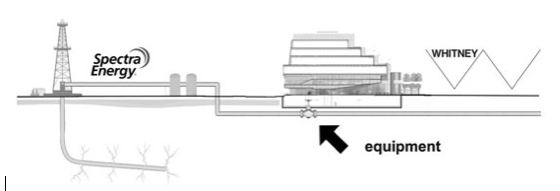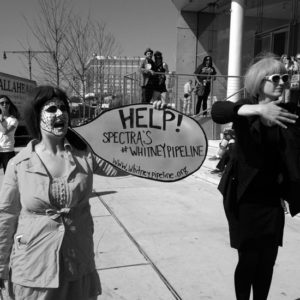Given that the Whitney now sits on fossil fuel infrastructure, is the art museum committed to exhibit art that explores themes such as the environment, energy, and how corporations operate in society? How will people and artworks be kept safe and protected if the pipeline explodes, and as the Whitney must be aware of how lax the maintenance and inspection rules are for pipelines, what independent risk mitigation action has it taken? Will the Whitney ensure that its art education, public and academic programs explore issues such as climate change and the role of art in relation to a safe, habitable environment for Americans and, indeed, all humankind? Does the Whitney believe the energy future of New York should be renewable sources rather than more reliance on fossil fuels that will add to climate change? Will the Whitney move forward with new environmental and ethics policies to enable it to play a responsible leadership role in the art world and achieve sustainability in a time of climate change, including full independence from fossil fuel interests?

These key questions have been proposed in a recent open letter to the Whitney Museum, signed by an international network of twenty-two art and environmental activist groups that includes the voices of Occupy the Pipeline, Sane Energy Project, Occupy Museums, Global Ultra Luxury Faction, Guerrilla Girls, United for Action and Liberate Tate. Responding to Spectra Energy’s plans for the NJ-NY Expansion Project, non-violent direct action and civil disobedience were set into motion in 2011 to raise public awareness and stop the construction of Spectra’s 30” diameter, high-pressure pipeline that is currently delivering fracked Marcellus shale gas from Pennsylvania via New Jersey under the Hudson River and West Side Highway to just south of 14th street.
Two lawsuits were filed against the Federal Energy Regulatory Commission and the Hudson River Trust the following year to stop the pipeline’s installation on grounds of failing to comply with the state’s Environmental Quality Review Act. Interestingly, the Trust had first voted against giving Spectra a thirty year lease worth $2.8 million for the Gansevoort Peninsula for “nonpark use,” but with pressure from chair Diana Taylor, Mayor Bloomberg’s girlfriend, it was approved.
Public opposition has continued to rally against a gas drilling industry that’s been permitted to bypass the Clean Water Act, the Clean Air Act as well as the Safe Drinking Water Act and, in the process, inflict irreversible damage upon people’s lives, our food supply, groundwater and ecosystem. The toxic and destructive reality of extracting gas from shale formations using high volume horizontal hydrofracking has been thoroughly studied and documented in depth. Unable to match overstated promises of clean burning, cheap energy for economic growth, it’s considered by some as no more than another Ponzi scheme built around an “inherently unprofitable” industry.
The Whitney Museum of American Art has been faced for decades with limited space for expanding its presence. The securing of this new downtown site in 2009 in the very trendy meatpacking district at the foot of the High Line finally offered the perfect chance. Renzo Piano’s spectacular 195,000 square foot, six-story architectural design was based on his idea of not “creating buildings indifferent to the city, but meeting places, where people will get together and share values.”
However, an underground vault also just happens to sit beneath the museum’s west steps that connects the Spectra pipeline with ConEd. The museum’s response to the media has been that “governmental regulators, who oversaw and monitored the pipeline’s construction, are responsible for ensuring that the pipeline’s ongoing operation meets all applicable standards and requirements.” But is this enough reassurance, given the long history of Spectra’s violations that have been cited by the Federal Pipeline and Hazardous Materials Safety Administration?
Grassroot advocates have sustained a lengthy, drawn out battle since New York’s 80’ moratorium on fracking, but last year, Governor Cuomo finally decided to listen. “I think it’s our responsibility to develop an alternative … for safe, clean economic development.” Bound by reports from state health and environmental officials, New York has banned fracking, the second state to have done so after Vermont. For Pennsylvania’s ruling powers, who’ve been pushing for their state to be the top natural gas producer, this came as a welcome decision. Bloomberg Business recently reported that half of all hydraulic fracturing operations in the U.S. will be “dead or sold” by the year’s end on account of oil company cutbacks due to reduced demand and high costs. No matter what, this industry remains a nightmare.
Activists inaugurated a ribbon-cutting ceremony of their own in April with projections by Illuminator filling the museum’s south side wall with messages such as Climate Change: Contemporary Land Art? Whitney, the Finest Collection of 20th-century American Art in the World, Now Featuring A Brand New Pipeline! A detailed second open letter to the Whitney ended with a call out for a dialogue between artists, community and the museum. Maybe the Whitney will end up surprising the public by making a move towards activism over complicity and initiating innovative and substantial ways to address these very pivotal issues.
The museum did hire German engineers to install a flood protection system after their experience with Hurricane Sandy. They will be addressing government regulatory agencies during an upcoming exhibition on NSA surveillance with artist, journalist and filmmaker Laura Poitras, whose powerful documentary, CITIZENFOUR, on Edward Snowden, has won an Academy Award. So, how will the museum respond as awareness and concerns spread? Yes it is the city that pushed this corporate project through. But like it or not, the new Whitney is now stuck with a pipeline for a neighbor.

